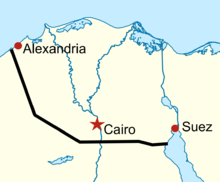Sumed pipeline
| Sumed pipeline | |
|---|---|
 Location of Sumed pipeline | |
| Location | |
| Country | Egypt |
| General direction | South–north |
| From | Ain Sukhna terminal |
| To | Sidi Kerir |
| Runs alongside | Suez Canal |
| General information | |
| Type | Oil |
| Partners | EGPC, Saudi Aramco, IPIC, three Kuwaiti companies, QGPC |
| Operator | Arab Petroleum Pipeline Company (Sumed Company) |
| Commissioned | 1977 |
| Technical information | |
| Length | 320 km (200 mi) |
| Maximum discharge | 2.5 million barrels per day (400×103 m3/d) |
The Sumed pipeline (also known as Suez-Mediterranean pipeline) is an oil pipeline in Egypt, running from the Ain Sukhna terminal on the Gulf of Suez to offshore Sidi Kerir, Alexandria[1] on the Mediterranean Sea. It provides an alternative to the Suez Canal for transporting oil from the Persian Gulf region to the Mediterranean.
History
The project for an oil pipeline from the Red Sea to the Mediterranean commenced after the extended closure of the Suez Canal in June 1967.[2] Establishment of the pipeline company was agreed in 1973 between five Arab governments.[3] The Sumed pipeline was opened in 1977.[4][5]
Technical description
The Sumed pipeline is 320 kilometres (200 mi) long. It consists of two parallel lines of 42 inches (1,070 mm) diameter. Its capacity is 2.5 million barrels per day (400×103 m3/d).[5] In 2009 it carried 1.1 million barrels per day (170×103 m3/d).[6]
Operator
The pipeline is owned by the Arab Petroleum Pipeline Company/Sumed Company, a joint venture of EGPC (50%, Egypt), Saudi Aramco (15%, Saudi Arabia), IPIC (15%, the United Arab Emirates), three Kuwaiti companies (each of 5%), and QGPC (5%, Qatar).
Proposed extension
An extension of the Sumed is being considered. The proposed extension would traverse the Red Sea from Ain Sukhna to the Saudi coast near Sharm al Sheikh, and from there to the terminal of Saudi Arabia's main east-west pipeline in Yanbu.
References
- ↑ http://www.worldportsource.com/ports/EGY_Sidi_Kerir_Terminal_2598.php
- ↑ Shwadran, Benjamin (1973). The Middle East, Oil, and the Great Powers. Israel Universities Press. p. 487. ISBN 978-0-470-79000-7.
- ↑ "Five Arab States Agree on Company For Sumed Pipeline". The New York Times. 1973-12-12. Retrieved 2009-03-28.
- ↑ Jehl, Douglas (1997-04-30). "Trying to revive a canal that is out of the loop". The New York Times. Retrieved 2009-03-28.
- 1 2 "Egypt to set up oil storage firm next year". Khaleej Times Online. 2007-05-08. Retrieved 2009-03-28.
- ↑ Strumpf, Dan; Whittaker, Matt (2011-01-29). "Egypt unrest stokes oil, gold". The Wall Street Journal. Retrieved 2011-02-06.